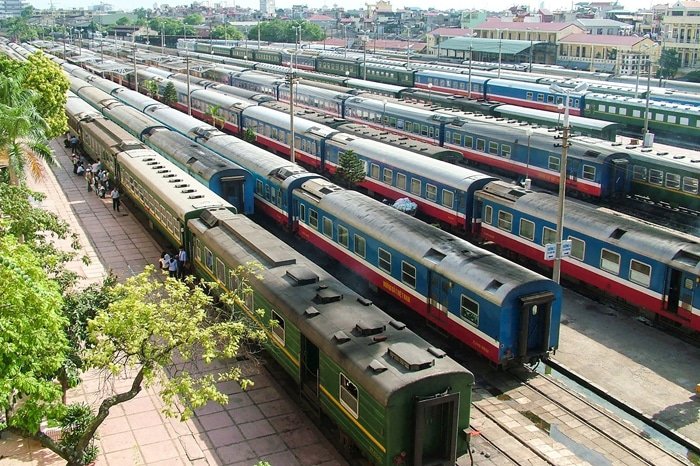
Introduction: Rail Freight’s Role in China-Vietnam Trade
As China and Vietnam continue to strengthen trade ties, the importance of diversified logistics solutions grows. Among these, railway transport has emerged as a cost-effective, sustainable, and increasingly efficient option. With ongoing investments in infrastructure and international cooperation, rail is becoming a vital link in the cross-border supply chain.
Shenzhen Guanwutong International Freight Forwarding Co., Ltd. is actively aligned with this shift. By leveraging rail solutions alongside sea, air, and road, we provide flexible, efficient logistics services from China to Vietnam and beyond.
Overview of Vietnam’s Railway System
Vietnam’s national railway system spans more than 3,000 kilometers and connects key regions such as Hanoi, Da Nang, and Ho Chi Minh City. While the system was historically underutilized due to outdated technology and limited capacity, recent modernization efforts are reinvigorating its role in national and international logistics.
Key Facts:
- Total length: 3,143 km
- Major operator: Vietnam Railways
- Primary gauge: Meter gauge (1,000 mm)
- Main routes: North-South (Hanoi-Ho Chi Minh City), Lao Cai-Hanoi, Hanoi-Hai Phong
Major Projects in Progress
A. North-South High-Speed Railway
- Length: ~1,500 km
- Speed: Up to 350 km/h
- Est. completion: 2035
- Investment: ~US$67 billion
- Significance: Will reduce travel from 30+ hours to under 10, while enabling high-speed cargo movement between Vietnam’s two largest cities.
B. Lao Cai-Hanoi-Hai Phong Line
- Purpose: Connect China-Vietnam border with Vietnam’s largest seaport (Hai Phong)
- Speed: 160 km/h (passenger), 120 km/h (freight)
- Estimated Investment: ~US$8.3 billion
- Completion Target: 2030
These projects are designed not just for passenger movement but for significant logistics applications, especially exports to/from industrial zones.
Benefits of Rail Freight from China to Vietnam
- Cost Efficiency: Lower costs for medium-to-heavy cargo compared to air.
- Time Savings: Faster than sea freight for land-locked regions like Yunnan, Guangxi.
- Environmental Impact: Rail produces less CO2 compared to trucks and planes.
- Border Connectivity: Rail routes from Kunming to Hanoi or Lao Cai reduce cross-border delays.
Guanwutong has developed partnerships along these corridors, ensuring cargo can be transferred seamlessly across modes and borders.
Integration with Other Modes: Multimodal Logistics
To serve our clients with precision, Guanwutong integrates rail with:
- Sea Freight: From China’s coastal ports to Vietnamese ports like Hai Phong and Ho Chi Minh.
- Road Freight: Last-mile delivery from rail depots to factories, warehouses, retailers.
- Fret aérien: For time-sensitive goods, we also provide air-rail combos where needed.
Multimodal logistics ensures your cargo moves through the most efficient and cost-effective routes.
China-Vietnam Border Rail Terminals
Key Cross-Border Points:
- Lao Cai – Hekou: Main China-Vietnam railway customs checkpoint.
- Dong Dang – Pingxiang: Facilitates freight movement in northern Vietnam.
- Mong Cai – Dongxing: Potential future railway linkage being explored.
These gateways are critical for customs clearance, which Guanwutong facilitates through pre-arrival documentation and digital declarations.
Government Cooperation & Investments
Vietnam and China have signed several bilateral agreements aimed at improving rail infrastructure and regulatory alignment:
- Harmonization of rail gauges for better interconnectivity
- Joint feasibility studies for new links (e.g., via Nanning or Chongzuo)
- Financing via Chinese concessional loans to build logistics-supporting infrastructure
These initiatives reflect both countries’ commitment to enhancing rail logistics.
Challenges to Overcome
While promising, Vietnam’s rail logistics faces several hurdles:
- Gauge incompatibility with Chinese standard gauge (1,435 mm)
- Limited handling facilities at terminals
- Aging locomotives and wagons on existing lines
- Regulatory misalignment between customs protocols
Guanwutong proactively addresses these through transloading services, flexible warehousing, and comprehensive customs support.
How Guanwutong Adds Value in Rail Logistics
a. Route Optimization
We analyze cargo needs and recommend ideal rail or multimodal paths.
b. Cross-Border Expertise
With local agents in both China and Vietnam, we minimize delays at checkpoints.
c. Document Management
We handle commercial invoices, B/Ls, rail waybills, and customs entries.
d. Tracking & Communication
Real-time updates and proactive alerts keep your supply chain visible and informed.
Industry Outlook: Future-Proofing Vietnam’s Logistics
Vietnam’s participation in the Regional Comprehensive Economic Partnership (RCEP) and its growing role in the China+1 manufacturing strategy are fueling demand for reliable logistics. Rail is set to become a backbone of mid-range freight between Chinese production zones and Vietnamese consumption markets.
As investments increase, stakeholders must align with capable logistics providers to stay competitive.
Conclusion: Rail as a Competitive Advantage
The future of China–Vietnam trade hinges on logistics agility. As rail networks improve, they will enable faster, greener, and more scalable trade routes. Shenzhen Guanwutong International Freight Forwarding Co, Ltd. offers the expertise, tools, and local knowledge to help you make the most of this transformation.
